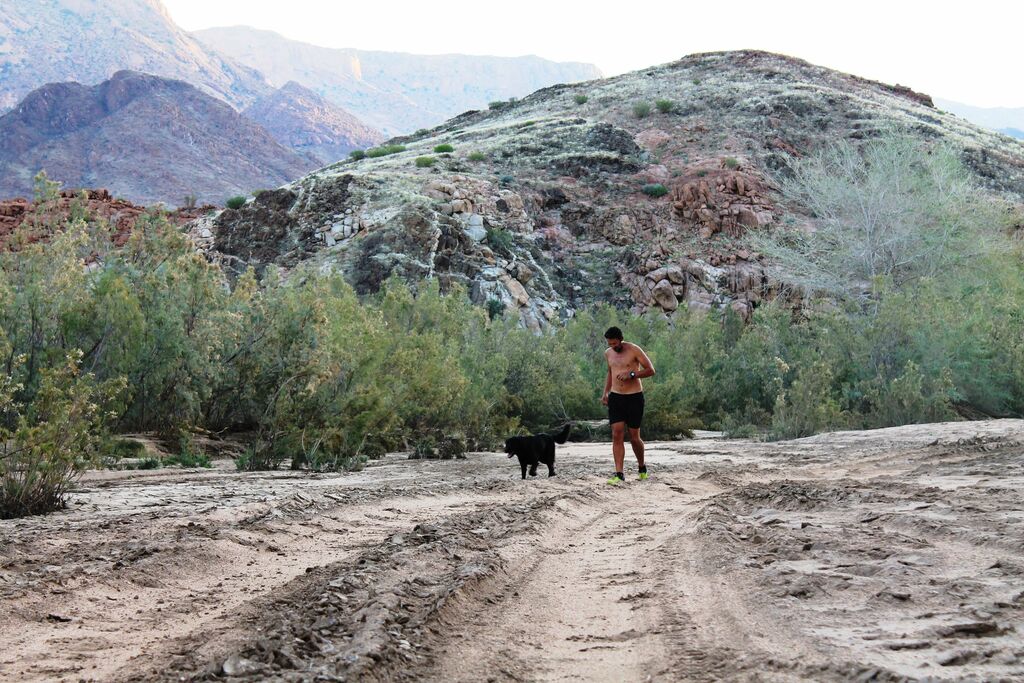Sand Running: Strength Training for Runners

As runners, we know that cross – and strength training is beneficial to our running. And it is often even prescribed to prevent or rehabilitate an injury. However, for many of us, the idea of sweaty, stationary exercise equipment in a stuffy gym is enough to bolt ourselves to the nearest couch.
But instead of sticking your head in the sand and plead ignorance, rather have a look at how training in sand can benefit a runner.

Training in Sand: The Gym for Non-Gymmers
Training in the soft sand may burn between 20 to 60 % more calories than training on compact surfaces. These were the findings of a study led by Paula Zamparo of the University of Verona. The study showed that the energy cost of walking in soft sand was, on average, 1.8 times greater than on compact terrain. Zamparo maintains that this is because the recovery of potential – and kinetic energy is much less in comparison to walking on a firm substrate. On the other hand, when running in sand the reduced recovery of elastic energy accounts for roughly 1.2 times more energy required than when running on a compact terrain.
The All-In-One Leg and Core Workout
So generally speaking, sand as a training substrate offers more resistance. This added resistance places a higher demand on muscle groups such as glutes, quads, hamstrings, and calves, which leads to a greater workout. And the benefits don’t stop there. With training in the sand comes uneven surfaces, which, in addition, calls for smaller stabilizing muscles and core muscles to engage. Making sand running a one-stop workout for a runner’s most important (running) parts.
According to Sean Ryan, physical therapist, and owner at Positive Energy Physical Therapy in Redondo Beach, California, sand running is one of the best ways to help prevent injuries. He adds that not only does sand running strengthen muscles in the core, legs, ankles, and feet, but it can also help to fix your form.

It is Kinder On the Joints
Recovery from injury or looking for an intense workout without the impact? Running in the sand may be the answer. Various studies have shown that, when comparing similar workouts on grass and sand, the latter resulted in significantly fewer inflammation markers measured and perceived DOMS.
According to Martyn Binnie, a physiologist at the Western Australian Institute of Sport, with every footstrike there is almost four times less of an impact force when treading on soft sand versus firm ground. Training at similar intensities in the sand may thus minimize musculoskeletal load while still reaping the same cardiovascular benefits.
Killer Sand Workouts
Don’t know how to hit the sand running? Here are some ways in which you can spice up your weekly running mix.

Interval Training
Whether you are looking to get back into running or get into sand running as a seasoned runner, interval training is a brilliant idea. Shorten your stride and increase your cadence to be as energy efficient as possible, says Courtney Atkinson, Australian Olympic triathlete who frequently trains in the sand.
For beginners, Atkinson recommends an interval of 30s jogging followed by 30s walking. Gradually increase the jogging intervals but walk as longs as is required to recover. This is the fastest way to build fitness but also to ease into sand running without running the risk of injury.
Dune Repeats
Training on dunes is much like hill training on steroids. As one of the world’s leading athletics coaches in the 1960s, Percy Cerutty was a firm believer in sand dune running as part of strength training. For optimum benefit, Cerutty suggested that dune repeats be done at full effort.
Depending on the height of the dunes available, try one of these two workouts.
1. Low sand dune sprints
On a low but steep (50+ degree incline) sand dune that takes less than 30 seconds to climb, start with a set of 10 repeats sprinting up. Use the descends to recover sufficiently to be ready to go out hard again once you reach the bottom.
2. Medium to longer dune repeats
If you have access to a dune that takes a minute or more to ascend, start with five repeats. Try to strike a balance between power and endurance, and increase reps each week.

Shake Things Up
Another successful coach that believes in the benefits of sand training is New York-based Ryan Palmer. He has his runners train barefoot and says that sand running makes runners fast while strengthening everything from hip flexors to tendons and ligaments.
For Palmer’s squad, there is hardly a typical training day. The only constant they can loosely count on is that there will be lots of sand involved. Their training may entail two-mile time trials on soft sand or sprinting up and down low dunes while carrying rocks.
The Final Two Cents
The ways in which to benefit from training in the soft sand are infinite. But for every new activity, there are usually handy guidelines that apply.
Running in soft sand also puts extra strain on calves and the Achilles tendon. Experts advise to avoid sand workouts for runners with a history of Achilles problems and to stop if calf pain is experienced.
Shaun Ryan also warns of an increased risk for microtrauma because sand is such an unstable surface. He advises using sand training sparingly like you would hill repeats or track work. He advises limiting sand training to once or twice weekly with sufficient recovery in-between by running on firmer surfaces.
Sources
- , Sand training: a review of current research and practical applications., Scientific Publication
- , Sand training: Exercise-induced muscle damage and inflammatory responses to matched-intensity exercise, Scientific Publication
- , How Running on the Beach Can Boost Your Performance, Online Publication
- , Benefits of Sand Running Make hill workouts tougher and more effective by doing them on sand., Online Publication
- , Why Running On Sand Is A Killer Conditioning Tactic, Online Publication
- , Percy Cerutty- The Eccentric Stotan, Online Publication
- , Sand and Strength, Online Publication
- , Why soft sand running is the killer summer workout you've been waiting for, Online Publication
Latest Articles
 Is Running on a Treadmill Easier Than Running Outside?Runners have their own preferences, whether it is treadmill running, running outside on the road, or exploring trails. So...
Is Running on a Treadmill Easier Than Running Outside?Runners have their own preferences, whether it is treadmill running, running outside on the road, or exploring trails. So... Is It OK to Use Trail Running Shoes on the Road?While trail running shoes can be used on roads, especially in situations where a runner encounters mixed terrains or pref...
Is It OK to Use Trail Running Shoes on the Road?While trail running shoes can be used on roads, especially in situations where a runner encounters mixed terrains or pref... How to Fix Sore Quads After Running?Rest, ice, gentle stretching, and over-the-counter pain relievers can help soothe sore quads after running. Also, ensure ...
How to Fix Sore Quads After Running?Rest, ice, gentle stretching, and over-the-counter pain relievers can help soothe sore quads after running. Also, ensure ... 10 Fruits With The Most Electrolytes to Replace Sports DrinksThese fruits are high in electrolytes such as potassium, magnesium, and calcium, essential for hydration, muscle function...
10 Fruits With The Most Electrolytes to Replace Sports DrinksThese fruits are high in electrolytes such as potassium, magnesium, and calcium, essential for hydration, muscle function...

